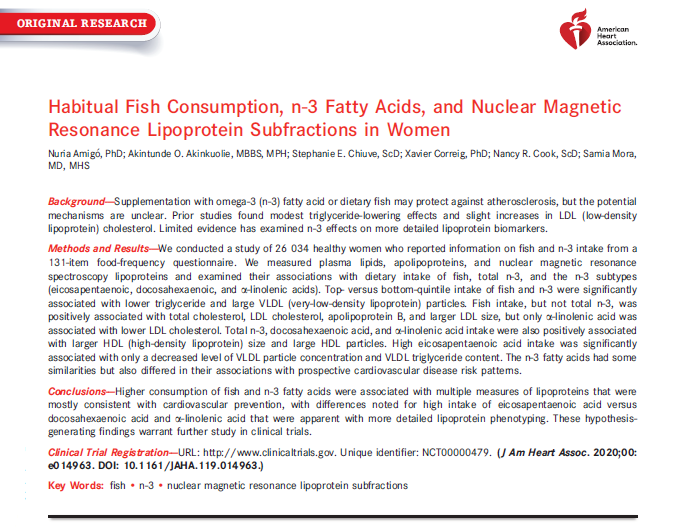Background
Supplementation with omega-3 (n-3) fatty acid or dietary fish may protect against atherosclerosis, but the potential
mechanisms are unclear. Prior studies found modest triglyceride-lowering effects and slight increases in LDL (low-density
lipoprotein) cholesterol. Limited evidence has examined n-3 effects on more detailed lipoprotein biomarkers.
Methods and Results
We conducted a study of 26 034 healthy women who reported information on fish and n-3 intake from a
131-item food-frequency questionnaire. We measured plasma lipids, apolipoproteins, and nuclear magnetic resonance
spectroscopy lipoproteins and examined their associations with dietary intake of fish, total n-3, and the n-3 subtypes
(eicosapentaenoic, docosahexaenoic, and a-linolenic acids). Top- versus bottom-quintile intake of fish and n-3 were significantly
associated with lower triglyceride and large VLDL (very-low-density lipoprotein) particles. Fish intake, but not total n-3, was
positively associated with total cholesterol, LDL cholesterol, apolipoprotein B, and larger LDL size, but only a-linolenic acid was
associated with lower LDL cholesterol. Total n-3, docosahexaenoic acid, and a-linolenic acid intake were also positively associated
with larger HDL (high-density lipoprotein) size and large HDL particles. High eicosapentaenoic acid intake was significantly
associated with only a decreased level of VLDL particle concentration and VLDL triglyceride content. The n-3 fatty acids had some
similarities but also differed in their associations with prospective cardiovascular disease risk patterns.
Conclusions
Higher consumption of fish and n-3 fatty acids were associated with multiple measures of lipoproteins that were
mostly consistent with cardiovascular prevention, with differences noted for high intake of eicosapentaenoic acid versus
docosahexaenoic acid and a-linolenic acid that were apparent with more detailed lipoprotein phenotyping. These hypothesisgenerating
findings warrant further study in clinical trials.



